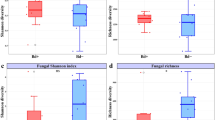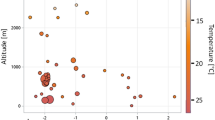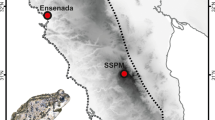Abstract
In the last several decades, amphibian populations have been declining worldwide. Many factors have been linked to global amphibian decline, including habitat destruction, pollution, introduced species, global environmental changes, and emerging infectious diseases. Recent studies of amphibian skin infections were mainly focused on the presence of chytridiomycosis, neglecting other members of the frogs’ skin communities. The diversity pattern of fungal dwellers on the skin of green frogs (Pelophylax esculentus complex) was investigated. A total of 100 adults were sampled from three localities in South Banat (northern Serbia) over three consecutive years and detected fungal dwellers were identified using light microscopy and ITS and BenA gene sequencing. Structures belonging to fungi and fungus-like organisms including a variety of spores and different mycelia types were documented in the biofilm formed on amphibian skin, and are classified into 10 groups. In total, 42 fungal isolates were identified to species, section, or genus level. The difference in mycobiota composition between sampling points (localities and green frog taxa) was documented. The highest number of fungal structures and isolates was recorded on the hybrid taxon P. esculentus and locality Stevanove ravnice. Parental species showed a markedly lower diversity than the hybrid taxon and were more similar in diversity patterns and were placed in the same homogenous group. The locality Stevanove ravnice exhibited more pronounced differences in diversity pattern than the other two localities and was placed in a distinct and separate homogenous group. Among the fungal isolates, the highest isolation frequency was documented for Alternaria alternata, Aspergillus sp. sect. Nigri, Epicoccum nigrum, Fusarium proliferatum, and Trichoderma atroviride. Among the documented species, dematiaceous fungi, causative agents of chromomycosis in amphibians, were also recorded in this research with high isolation frequency. Also, some rare fungal species such as Quambalaria cyanescens and Pseudoteniolina globosa are documented for the first time in this research as microbial inhabitants of amphibian skin.




Similar content being viewed by others

Data Availability
The datasets generated and analyzed during the current study are available from the corresponding author on reasonable request.
References
Xu X, Lai R (2015) The chemistry and biological activities of peptides from amphibian skin secretions. Chem Rev 115(4):1760–1846. https://doi.org/10.1021/cr4006704
Huang L, Li J, Anboukaria H, Luo Z, Zhao M, Wu H (2016) Comparative transcriptome analyses of seven anurans reveal functions and adaptations of amphibian skin. Sci Rep 6(1):1–11. https://doi.org/10.1038/srep24069
Kueneman JG, Parfrey LW, Woodhams DC, Archer HM, Knight R, McKenzie VJ (2014) The amphibian skin-associated microbiome across species, space and life history stages. Mol Ecol 23(6):1238–1250. https://doi.org/10.1111/mec.12510
Berger L, Speare R, Hyatt A (1999) Chytrid fungi and amphibian declines: overview, implications and future directions. In: Campbell A (ed) Declines and disappearances of Australian frogs. Environment Australia, Canberra, pp 23–33
Walke JB, Belden LK (2016) Harnessing the microbiome to prevent fungal infections: lessons from amphibians. PLoS Pathog 12(9):e1005796. https://doi.org/10.1371/journal.ppat.1005796
Christian K, Weitzman C, Rose A, Kaestli M, Gibb K (2018) Ecological patterns in the skin microbiota of frogs from tropical Australia. Ecol Evol 8(21):10510–10519. https://doi.org/10.1002/ece3.4518
Brucker RM, Harris RN, Schwantes CR, Gallaher TN, Flaherty DC, Lam BA, Minbiole KP (2008) Amphibian chemical defense: antifungal metabolites of the microsymbiont Janthinobacterium lividum on the salamander Plethodon cinereus. J Chem Ecol 34(11):1422–1429. https://doi.org/10.1007/s10886-008-9555-7
Harris RN, Brucker RM, Walke JB, Becker MH, Schwantes CR, Flaherty DC, Lam BA, Woodhams DC, Briggs CJ, VredenburgVT MKPC (2009) Skin microbes on frogs preventmorbidity and mortality caused by a lethal skin fungus. TheISME J 3:818–824. https://doi.org/10.1038/ismej.2009.27
Woodhams DC, Brandt H, Baumgartner S, Kielgast J, Küpfer E, Tobler U, Davis LR, Schmidt BR, Bel C, Hodel S, Knight R (2014) Interacting symbionts and immunity in the amphibian skin mucosome predict disease risk and probiotic effectiveness. PLoS One 9(4):e96375. https://doi.org/10.1371/journal.pone.0096375
Pessier AP (2002) An overview of amphibian skin disease. Semin Avian Exot Pet Med 11:162–174. https://doi.org/10.1053/saep.2002.123980
Paré JA (2003) Fungal diseases of amphibians: an overview. Vet Clin North Am Exot Anim Pract 6:315–326. https://doi.org/10.1016/s1094-9194(03)00006-9
Densmore CL, Green DE (2007) Diseases of amphibians. ILAR J 48:235–254. https://doi.org/10.1093/ilar.48.3.235
Medina D, Hughey MC, Walke JB, Becker MH, Pontarelli K, Sun S, Badgley B, Belden LK (2019) Amphibian skin fungal communities vary across host species and do not correlate with infection by a pathogenic fungus. Environ Microbiol 21(8):2905–2920. https://doi.org/10.1111/1462-2920.14682
Krizmanić I, Ivanović A (2010) Population systems of the Pelophylax complex in the southern part of its range. Folia Zool 59(3):215–222. https://doi.org/10.25225/fozo.v59.i3.a7.2010
Mali I, Villamizar-Gomez A, Krizmanić I, Ajtić R, Forstner MR (2017) Evidence of Batrachochytrium dendrobatidis infection in amphibians from Serbian lowlands. J Wildl Dis 53(3):686–689. https://doi.org/10.7589/2016-07-172
Stupar M, Breka K, Krizmanić I, Stamenković S, Unković N, Savković Ž, Vukojević J, Ljaljević Grbić M (2017) First case report on pathogenic fungus Fonsecaea sp. Negroni from skin of Pelophylax kl. esculentus L. in Serbia. Matica Srpska J Nat Sci 133:307–314. https://doi.org/10.2298/ZMSPN1733307S
Stupar M, Breka K, Krizmanić I, Stamenković S, Ljaljević Grbić M (2020) First report of water mold (Aphanomyces sp.) documented on skin of pool frog (Pelophylax lessonae) in Serbia. North-West J Zool 16(2):216–219
Breka K, Krizmanic I, Vukov T, Stamenkovic S (2020) A procedure for taxon assessment based on morphological variation in European water frogs (Pelophylax esculentus complex). Turk J Zool 44(3):214–223. https://doi.org/10.3906/zoo-1912-29
Bensch K, Braun U, Groenewald JZ, Crous PW (2012) The genus Cladosporium. Stud Mycol 72:1–401. https://doi.org/10.3114/sim0003
Kubatova A, Cerny M, Novakova A (2001) New records of micromycetes from the Czech Republic. IV. Acrodontium salmoneum, Chaunopycnis alba, and Cylindrocarpostylus gregarious, and notes on Dactylaria lanosa and Trichoderma saturnisporum. Czech Mycol 53:237–255. https://doi.org/10.33585/cmy.53308
Lević J (2008) Vrste roda Fusarium – monografija. Institut za kukuruz – Društvo genetičara Srbije, Belgrade
Lombard L, Houbraken J, Decock C, Samson RA, Meijer M, Réblová M, Groenewald JZ, Crous PW (2016) Generic hyper-diversity in Stachybotriaceae. Persoonia 36:156–246. https://doi.org/10.3767/003158516X691582
Manamgoda DS, Rossman AY, Castlebury LA, Crous PW, Madrid H, Chukeatirote E, Hyde KD (2014) The genus Bipolaris. Stud Mycol 79:221–288. https://doi.org/10.1016/j.simyco.2014.10.002
Pitt JI (1979) The genus Penicillium and its teleomorphic state Eupenicillium and Talaromyces. Academic Press, London-New York-Toronto-Sydney-San Francisco
Raper BK, Fennell DI (1965) The genus Aspergillus. The Williams and Wilkins Company, Baltimore
Rizk SM, Magdy M, Leo FD, Werner O, Rashed MAS, Ros RM, Urzì C (2021) A new extremotolerant ecotype of the fungus Pseudotaeniolina globosa isolated from Djoser Pyramid, Memphis Necropolis. Egypt. J Fungi 7(2):104. https://doi.org/10.3390/jof7020104
Samson RA, Houbraken J, Thrane U, Frisvad JC, Andersen B (2010) Food and indoor fungi. Westerdijk Fungal Biodiversity Institute, Utrecht
Schroers HJ, Samuels GJ, Seifert KA, Gams W (1999) Classification of the mycoparasite Gliocladium roseum in Clonostachys as C. rosea, its relationship to Bionectria ochroleuca, and notes on other Gliocladium-like fungi. Mycologia 91(2):365–385. https://doi.org/10.1080/00275514.1999.12061028
Wang XW, Houbraken J, Groenewald JZ, Meijer M, Andersen B, Nielsen KF, Crous PW, Samson RA (2016) Diversity and taxonomy of Chaetomium and Chaetomium-like fungi from indoor environments. Stud Mycol 84:145–224. https://doi.org/10.1016/j.simyco.2016.11.005
Ward HB, Whipple GC (1959) Fresh-water biology, 2nd edition. Edmondson WT (ed). John Wiley & sons, Incorporated
Woudenberg JHC, Groenewald JZ, Binder M, Crous PW (2013) Alternaria redefined. Stud Mycol 75:171–212. https://doi.org/10.3114/sim0015
White TJ, Bruns T, Lee S, Taylor JW (1990) Amplification and direct sequencing of fungal ribosomal RNA genes for phylogenetics. In: Innis MA, Gelfand DH, Sninsky JJ, White TJ (eds) PCR protocols: a guide to methods and applications. Academic Press, New York, pp 315–322
Glass NL, Donaldson GC (1995) Development of primer sets designed for use with the PCR to amplify conserved genes from filamentous ascomycetes. Appl Environ Microbiol 61:1323–1330. https://doi.org/10.1128/aem.61.4.1323-1330.1995
Savković Ž, Stupar M, Unković N, Ivanović Ž, Blagojević J, Vukojević J, Ljlaljević Grbić M (2019) In vitro biodegradation potential of airborne Aspergilli and Penicillia. Sci Nat 106(3–4):8. https://doi.org/10.1007/s00114-019-1603-3
Tamura K, Stecher G, Peterson D, Filipski A, Kumar S (2013) MEGA6: molecular evolutionary genetics analysis version 6.0. Mol Biol Evol 30:2725–2729. https://doi.org/10.1093/molbev/mst197
Zar JH (2010) Biostatistical Analysis (5th ed.). Prentice-Hall, Englewood Cliffs. New Jersey 944
Hammer Ø, Harper DAT, Ryan PD (2001) PAST: Paleontological statistics software package for education and data analysis. Palaeontol Electron 4:9. (http://palaeo-electronica.org/2001_1/past/issue1_01.htm)
Jongman RHJ, Braak CJF, Tongeren OFR (1995) Data analysis in community and landscape ecology: List of Contributors. Cambridge University, Cambridge, pp 91–173
Ter Braak CJ, Smilauer P, (2002) CANOCO reference manual and CanoDraw for Windows user’s guide: software for canonical community ordination (version 5.12)
Martinović-Vitanović MV, Milankov MV, Kalafatić IV (2010) First record of freshwater bryozoans (Bryozoa: Phylactolaemata) in the aquatic invertebrate fauna of Serbia. Limnologica 40(1):73–91. https://doi.org/10.1016/j.limno.2009.04.001
Daum JM, Davis LR, Bigler L, Woodhams DC (2012) Hybrid advantage in skin peptide immune defenses of water frogs (Pelophylax esculentus) at risk from emerging pathogens. Infect Genet Evol 12(8):1854–1864. https://doi.org/10.1016/j.meegid.2012.07.024
Mangoni ML, Luca V, McDermott AM (2015) Fighting microbial infections: a lesson from amphibian skin-derived esculentin-1 peptides. Peptides 71:286–295. https://doi.org/10.1016/j.peptides.2015.04.018
Kueneman JG, Weiss S, McKenzie VJ (2017) Composition of micro-eukaryotes on the skin of the cascades frog (Rana cascadae) and patterns of correlation between skin microbes and Batrachochytrium dendrobatidis. Front Microbiol 8:2350. https://doi.org/10.3389/fmicb.2017.02350
da Silva Peixoto A, de Sousa Guedes D, dos Santos-Bentes V, da Silva NS, Cant ESM, Kawashita-Ribeiro RA, Fernandes GDST (2020) Fungal community on skin tissue of amphibians collected in the Santarém region, Pará, Brazil. Braz J Dev 6:82336–82356. https://doi.org/10.34117/bjdv6n10-604
Kuan CS, Yew SM, Toh YF, Chan CL, Lim SK, Lee KW, Na SL, Hoh CC, Yee WY, Ng KP (2015) Identification and characterization of a rare fungus, Quambalaria cyanescens, isolated from the peritoneal fluid of a patient after nocturnal intermittent peritoneal dialysis. PLoS ONE 10:e0145932. https://doi.org/10.1371/journal.pone.0145932
Stevanović V, Šinžar-Sekulić J, Stevanović B (2003) On the distribution and ecology of macrophytic flora and vegetation in the river Danube reservoir between Žilovo islet and the mouth of the Nera tributary (river km 1091 and 10754). River Syst 147:283–295. https://doi.org/10.1127/lr/14/2003/283
Walke JB, Becker MH, Loftus SC, House LL, Cormier G, Jensen RV, Belden LK (2014) Amphibian skin may select for rare environmental microbes. ISME J 8(11):2207–2217. https://doi.org/10.1038/ismej.2014.77
Rebollar EA, Martínez-Ugalde E, Orta AH (2020) The amphibian skin microbiome and its protective role against chytridiomycosis. Herpetologica 76(2):167–177. https://doi.org/10.1655/0018-0831-76.2.167
Kearns PJ, Fischer S, Fernández-Beaskoetxea S, Gabor CR, Bosch J, Bowen JL, Tlusty MF, Woodhams DC (2017) Fight fungi with fungi: antifungal properties of the amphibian mycobiome. Front Microbiol 8:2494. https://doi.org/10.3389/fmicb.2017.02494
Nierman WC, Fedorova-Abrams ND, Andrianopoulos A (2015) Genome sequence of the AIDS-associated pathogen Penicillium marneffei (ATCC18224) and its near taxonomic relative Talaromyces stipitatus (ATCC10500). Genome Announc 3(1):e01559-e1614. https://doi.org/10.1128/genomeA.01559-14
Elmassry MM, Dowd S, Carey C, San Francisco MJ (2020) Evaluation of the bacterial and fungal microbiome on the skin of Anaxyrus boreas, Rhinella marina, and Xenopus laevis and implications related to Batrachochytrium dendrobatidis susceptibility. bioRxiv. https://doi.org/10.1101/2020.07.19.211102
Douglas SI, Amuzie CC (2017) Microbiological quality of Hoplobatrachus occipitalis (Amphibia, Anura) used as meat. Int J Curr Microb Appl Sci 6(6):3192–3200. https://doi.org/10.20546/IJCMAS.2017.606.376
Ogoanah OS, Okafor AE, Eyong MM (2017) Effect of different preparatory methods on microbial load of the edible frog Hoplobatrachus occipitalis from Aguleri, Anambra State. Nigeria NISEB J 17(3):91–95
Bizjak-Mali L, Zalar P, Turk M, Babič MN, Gunde-Cimerman N (2018) Opportunistic fungal pathogens isolated from a captive individual of the European blind cave salamander Proteus anguinus. Dis Aquat Org 129(1):15–30. https://doi.org/10.3354/dao03229
Kim S, Eom A-H, Park D, Ra N-Y (2008) Detection of infectious fungal diseases of frogs inhabiting in Korea. Mycobiology 36:10–12. https://doi.org/10.4489/MYCO.2008.36.1.010
Nickerson CA, Ott CM, Castro SL, Garcia VM, Molina TC, Briggler JT, Pitt AL, Tavano JJ, Kelly Byram J, Barrila J, Nickerson MA (2011) Evaluation of microorganisms cultured from injured and repressed tissue regeneration sites in endangered giant aquatic Ozark hellbender salamanders. PLoS ONE 6(12):e28906. https://doi.org/10.1371/journal.pone.0028906
Mendoza ÁM, Aguirre-Rojas L, Sarria M, Giraldo A (2012) Hongos dérmico saprófitos de Dendropsophus columbianus (Hylidae) en Caloto. Colombia Bol Cient 16(1):33–40
Qualhato TF, Lopes FAC, Steindorff AS, Brandao RS, Jesuino RSA, Ulhoa CJ (2013) Mycoparasitism studies of Trichoderma species against three phytopathogenic fungi: evaluation of antagonism and hydrolytic enzyme production. Biotechnol Lett 35(9):1461–1468. https://doi.org/10.1007/s10529-013-1225-3
Funding
Authors received financial support of their research from the Ministry of Education, Science and Technological Development of the Republic of Serbia [Contract No.451–03-9/2021–14/ 200178].
Author information
Authors and Affiliations
Contributions
MS, KB, MLjG, SS, and IK contributed to the study conception and design. Field sampling was performed by MS, KB, SS, and IK. MS and ŽS conducted experiments. The first draft of the manuscript was written by MS, ŽS, and KB. All other authors commented on the previous versions of the manuscript. Funding acquisition: JV and KB. Supervision: MS, MLjG, and SS. All authors read and approved the final manuscript.
Corresponding author
Ethics declarations
Ethics Approval
Collecting adult Pelophylax esculentus complex frogs from a natural population was approved by the Ministry of Environmental Protection of the Republic of Serbia (Permits No. 353–01-1170/2016–17 and 353-0 l-370/2018–04).
Consent to Participate
All authors agreed to participate.
Consent for Publication
All authors are informed and agreed to publish.
Competing Interests
The authors declare no competing interests.
Additional information
Jelena Vukojević died during the time of study.
Supplementary Information
Below is the link to the electronic supplementary material.
Rights and permissions
Springer Nature or its licensor (e.g. a society or other partner) holds exclusive rights to this article under a publishing agreement with the author(s) or other rightsholder(s); author self-archiving of the accepted manuscript version of this article is solely governed by the terms of such publishing agreement and applicable law.
About this article
Cite this article
Stupar, M., Savković, Ž., Breka, K. et al. A Variety of Fungal Species on the Green Frogs’ Skin (Pelophylax esculentus complex) in South Banat. Microb Ecol 86, 859–871 (2023). https://doi.org/10.1007/s00248-022-02135-0
Received:
Accepted:
Published:
Issue Date:
DOI: https://doi.org/10.1007/s00248-022-02135-0



